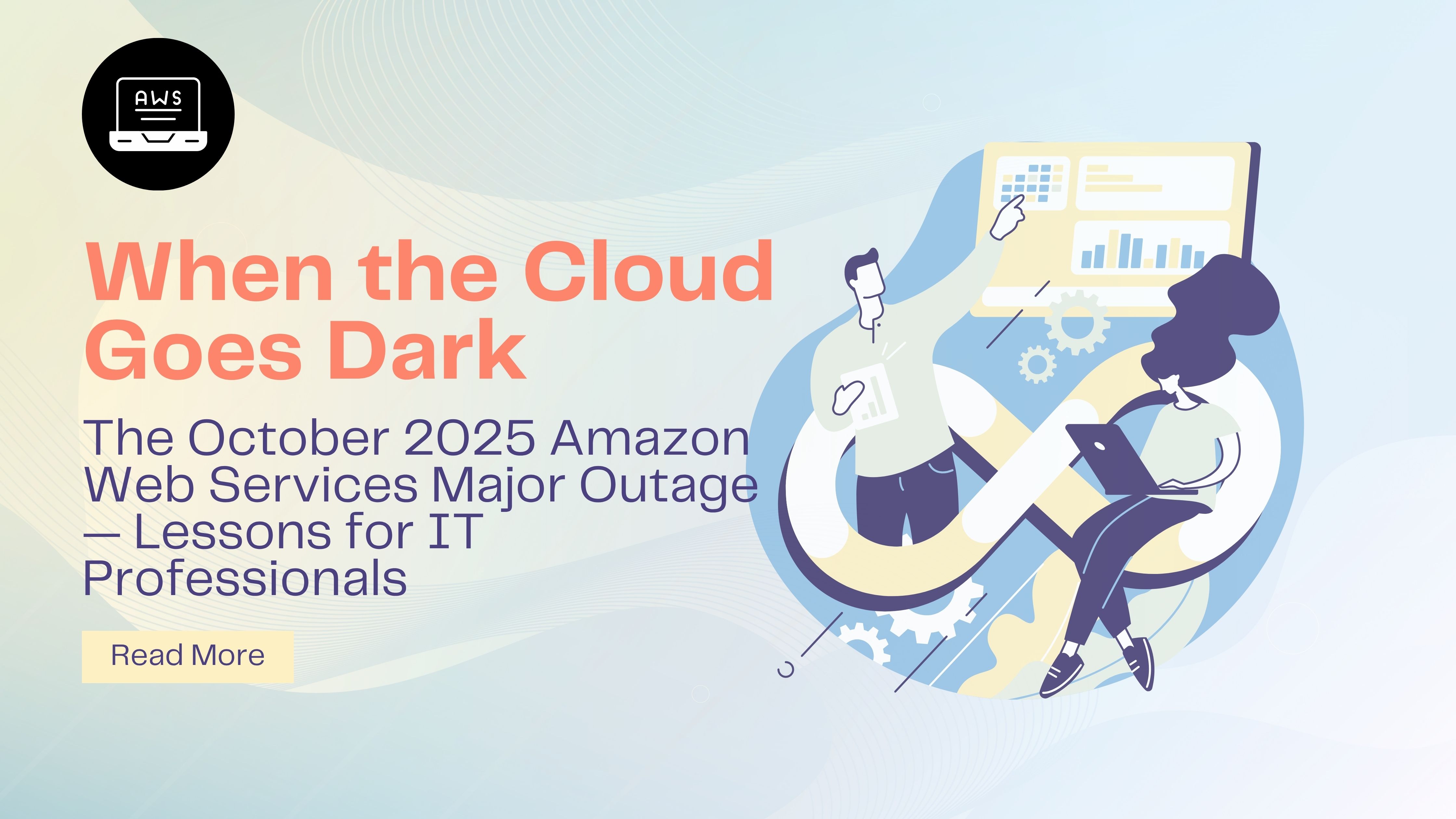
When the Cloud Goes Dark: The October 2025 AWS Outage and What It Teaches Every IT Professional
Introduction
When the world’s largest cloud provider goes down, the internet trembles. On October 20, 2025, Amazon Web Services (AWS) suffered a massive outage in its US-East-1 (Northern Virginia) region — a single event that rippled across industries, crippling applications, devices, and entire businesses.
From gaming platforms like Roblox to smart-home devices like Ring, the impact was widespread. The incident serves as a powerful reminder that even the cloud isn’t infallible — and it offers critical lessons for IT professionals, engineers, and students preparing for real-world challenges.
1. What Happened
The outage began early Monday morning, around 3 a.m. ET, when users and companies started reporting slowdowns and failed API calls across AWS services. By mid-morning, several key platforms — including Snapchat, Duolingo, Signal, and multiple enterprise applications — were experiencing interruptions.
AWS later confirmed that the issue originated in US-East-1, a region that hosts a large percentage of AWS’s global workloads.
Although full recovery was achieved later that day, the aftershocks continued: delayed data synchronization, failed background jobs, and degraded monitoring systems.
2. Root Cause Breakdown
a) DNS Resolution Failure
The primary cause was a DNS resolution failure in the DynamoDB endpoints of the US-East-1 region. DynamoDB is a foundational database service in AWS, and its failure disrupted thousands of dependent microservices across the ecosystem.
b) Health Monitoring Subsystem Glitch
A secondary issue emerged in the network load-balancer health monitoring subsystem, which became overloaded and started throttling new EC2 instance launches. This safety mechanism, meant to prevent overloads, ironically contributed to longer restoration times.
c) Cascading Dependencies
Because US-East-1 is one of the largest and most interconnected AWS regions, the initial fault quickly cascaded through dependent services, amplifying the outage’s reach.
3. Technical Timeline
-
03:00 a.m. ET: Internal DNS failures detected for DynamoDB endpoints.
-
03:15 a.m.: Health monitoring systems begin abnormal throttling; EC2 instance launches restricted.
-
04:00 a.m.–06:00 a.m.: Multiple AWS services — including Lambda, CloudFormation, and Route 53 — show increased error rates.
-
07:00 a.m.: Global customer-facing platforms start reporting outages.
-
11:00 a.m.: AWS engineers manually disable problematic automation and initiate DNS corrections.
-
05:00 p.m.: Core services restored; residual effects (logs, replication lag, metrics) persist into the evening.
4. Impact on Businesses and End-Users
AWS supports a vast portion of modern digital infrastructure — from entertainment and fintech to healthcare and IoT.
The outage caused:
-
Global application downtime for major platforms.
-
E-commerce and financial transaction failures.
-
IoT device malfunctions in smart-home systems.
-
Reputational and financial losses for countless businesses.
The event reminded the world that even the most reliable cloud infrastructure is susceptible to single-region dependency risks.
5. Lessons for IT Professionals
1. Avoid Single-Region Dependency
Design applications with multi-region or multi-cloud redundancy. Never rely solely on one geographic location for high-availability workloads.
2. Understand Service Interdependencies
Cloud environments are interconnected. A fault in one component — such as DNS or a load balancer — can bring down seemingly unrelated services.
3. Strengthen Observability and Monitoring
Build robust alerting, anomaly detection, and log correlation tools to spot issues before they cascade.
4. Balance Automation with Control
Automations can fail too. Always maintain manual override procedures and ensure teams can act swiftly without relying entirely on scripts.
5. Communicate Effectively During Crises
Clear, transparent communication during outages builds trust and mitigates customer frustration.
6. Conduct a Strong Post-Incident Review
Every outage should end with a Root Cause Analysis (RCA), documented lessons learned, and updates to runbooks, escalation policies, and architecture diagrams.
6. Educational Value for Career Cracker Learners
At Career Cracker Academy, this incident makes an excellent real-life case study for students enrolled in:
-
Service Transition and Operations Management (STOM)
-
Cloud Fundamentals
-
ServiceNow Incident Management
How It Can Be Used in Training
-
Simulate the AWS outage in a mock incident bridge to practice escalation and communication.
-
Design a multi-region failover strategy as a hands-on cloud architecture exercise.
-
Create a ServiceNow dashboard to track outage timelines, impacted services, and recovery progress.
-
Conduct a post-incident review session, focusing on RCA documentation and preventive action plans.
7. Actionable Recommendations for Enterprises
-
Implement redundant DNS configurations and ensure fallback to alternative resolvers.
-
Periodically test disaster recovery drills that simulate regional AWS outages.
-
Document service dependencies clearly within architecture diagrams.
-
Introduce cross-cloud monitoring using tools like Datadog, Dynatrace, or CloudWatch + Grafana.
-
Integrate automated escalation paths through ITSM platforms such as ServiceNow or PagerDuty.
8. Conclusion and Call to Action
The October 2025 AWS outage proves one thing: even the most advanced systems can fail. What matters most is resilience, visibility, and preparedness.
For IT professionals, this is not merely an event to read about — it’s a case study in cloud reliability, incident management, and operational excellence.
If you want to master the real-world skills needed to handle such large-scale incidents — from detection to post-incident review — explore our Service Transition and Operations Management and Cloud Fundamentals courses at Career Cracker Academy.
Learn how to stay calm when the cloud goes dark — and how to bring it back to light.
Hiring Partners










































